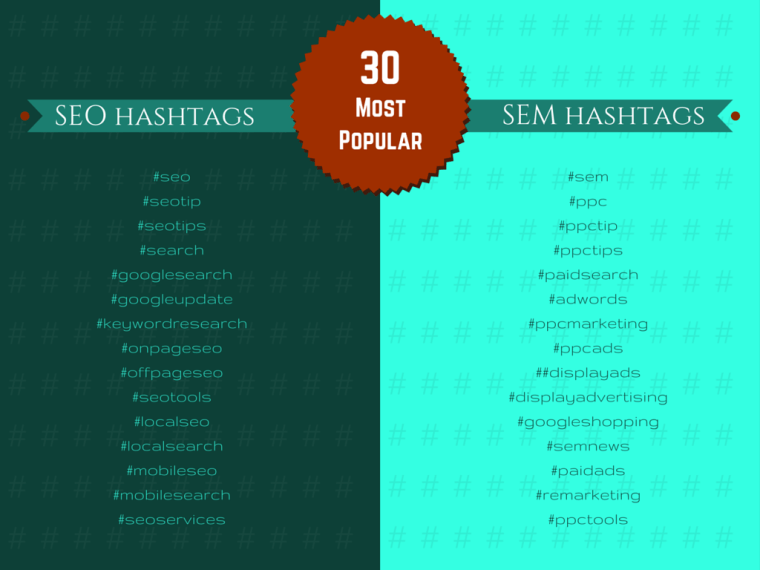How did a pound sign take over social media? Hashtags seem to be everywhere. Whether you love them or hate them, it’s hard to imagine social media without them. Originating on Twitter, hashtags are now spotted on most major sites, including Facebook, Instagram, Google+, LinkedIn, and Pinterest. You can also see them on Tumblr, Vine, and YouTube.
Far from simply being quirky, hashtags are a social media currency that you have to know how to spend. In this article, you will find out why you should use hashtags, how to use them effectively, and how to find the best hashtags to use and analyze them. Let’s dive in!
How Hashtags Help You
So what’s the point of using hashtags anyway? Two major benefits are their use in content filtering and content discovery. According to Internet Live Stats, there are more than 500 million tweets posted each day on Twitter. That’s a lot of content to wade through, and that’s just on one site. Hashtags help by tagging content to help social media users to search and filter it.
For example, if you want to find everything that’s been posted recently on the topic of social media on Twitter, then all you have to do is search for #socialmedia and you will see the results. People use this feature to follow news, sporting events, TV shows, brands, and more. It’s a way of taming the social media firehose so people can find valuable information when they need it.
So how does this help you as an entrepreneur, business, or brand? Here are five benefits:
- Using hashtags correctly makes you appear on-trend and tuned into current events. In other words, hashtags make you look relevant to your social media followers, and relevance is what makes them stick around.
- Hashtags can increase brand prominence and recognition for your campaigns. It’s something Coca-Cola does well, for example with the recent #shareacoke campaign.
- Using hashtags helps your audience to find your content, wherever you happen to post it.
- Using the same hashtags across multiple social media platforms and analyzing engagement gives a holistic picture of your reach.
- Using hashtags in a fun, quirky way can show your brand’s personality.
How to Use Hashtags Effectively
So how can you make hashtags work for you? Here are some tips to help you get the most from hashtag use.
- Know what’s trending: If you want to be relevant, you need to use the hashtags that people are searching for. Check out the trending topics on Twitter (in the box on the right of your timeline). Pro tip: If you market your business globally, change the country to see what’s trending in different parts of the world. For cross-platform social media trends, use Social Mention, which will show you the top related hashtags for any search term. Find trending hashtags and use them in your content to improve your reach.
- Avoid overuse: It’s worth noting that, except for Instagram (more on that in the next tip), you should limit your hashtag use to three. Too many hashtags can overwhelm your post, especially on Twitter with its 140-character limit.
- Go beyond the suggested hashtags: Google+ automatically suggests hashtags for your posts, but these aren’t always the best ones to use. Instead of automatically accepting the suggestions, use your information on trending topics to add new hashtags. And if you reshare content, consider adding up to three new hashtags to help even more people to find the content.
 Image created by author for SEJ
Image created by author for SEJ- Use hashtag recycling (Instagram). Instagram is a hashtag user’s paradise because you can use pretty much as many hashtags as you want (well, up to 30, anyway). Not only that, but if you DON’T use hashtags, no-one will find your stuff.
Here’s a good Instagram strategy. In addition to the hashtags in your post, add up to five other hashtags in a comment. Later, you can delete those and add five new ones. This hashtag recycling strategy helps increase exposure for your Instagram post over time.
- Search and filter. Hashtags are a great content marketing tool. At SEMrush, we look for SEO-related hashtags (such as #SEO, #SERP and others) to find new content in this niche and connect with the people who are sharing it.
Hashtags also work well for internal use, so you can easily filter posts and track their success. Some of those used by our team for this purpose include #semrushblog, #fun, #tipoftheday.
- Roll your own hashtag. If you’re starting a campaign, don’t be afraid to use your own hashtag. If you have an idea, the first step is to check that no-one else is using it on Hashtags.org.
For best results, make sure your hashtag is understandable and can’t be hijacked. Hashtags can easily turn into “bashtags,” as many companies have discovered to their cost.
 Image credit: Unsplash.com
Image credit: Unsplash.com8 Tools for Finding & Analyzing Hashtags
Finding the right hashtags is an important part of using them well. And it’s also important to be able to track their reach. Here are some tools to help with that.
- Ritetag says it covers 10 million+ hashtags and finds the relationships between them so that you can always be on trend with hashtag use. The tool works on the web or as a browser extension. It combines hashtag discovery and analysis for Twitter and Google+ and integrates with Sprout Social and Hootsuite. A cool feature of Ritetag is the ability to analyze your past tweets to see how you could have optimized hashtag use for greater reach.
- Hashtagify takes a more visual approach featuring a graphic linking the top hashtags related to a particular topic. Click on a tag to find a popularity score and correlation score so you can find the best hashtags to use. You can also use the tool to find and connect with influencers using hashtags related to your niche. Hashtagify helps you identify patterns of hashtag use, as well as how hashtags are used across social media sites.
- SEMrush (where I’m the Director of Social Media) is a great tool for finding hashtags. If this is a surprise, consider this: hashtags are like keywords, so using the related keyword report within SEMrush can help you find other ways to tag your content for increased reach. Combine this with other research and analysis tools to unify your hashtag and SEO strategy.
- Keywordtool.io polls several Google regional databases to help you to find relevant keywords which you can use as hashtags. While its options are limited, as a free tool, it’s definitely worth considering.
- TweetBinder allows you to analyze tweets around a single hashtag. It has free and premium versions, with the free version allowing you to analyze up to 300 tweets (a limit it’s surprisingly easy to reach). For each hashtag you can find out the number of tweets, mentions and uses, the Twitter handles of those using the hashtag and more. The premium version includes Excel reporting.
- Keyhole allows hashtag tracking on Twitter, Instagram, and Facebook. It works in real-time which can help with relevance, and provides useful charts and graphs on topics, sources, location, and demographics to aid analysis.
- Topsy is one of the early Twitter analysis tools which allows advanced searches and provides analytics and trends info. You can analyze hashtags and tweets in multiple languages and time periods and can also find trending topics. Most functionality is available for free.
- Iconosquare lets you get key metrics about your Instagram account. It’s a great way to not only search for public trending hashtags but to see how your hashtag use is working.
Use the tools about to identify and analyze the best hashtags and you can make them work well for SEO, content marketing and branding. What’s your favorite social media hashtag?
Featured image via Pixabay.com






![[SEO, PPC & Attribution] Unlocking The Power Of Offline Marketing In A Digital World](https://www.searchenginejournal.com/wp-content/uploads/2025/03/sidebar1x-534.png)